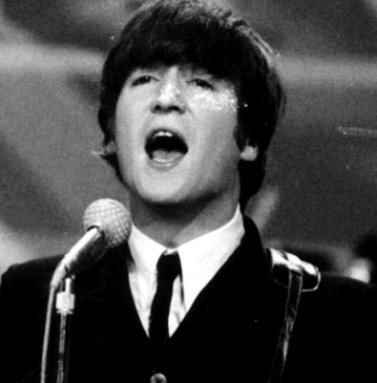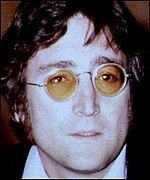John Lennon
Archive and John Lennon Articles Dedicated To The Greatest Singer Songwriter And The Most Influential Political Artist Of The 20th Century.


John Winston Ono Lennon
John Winston Ono Lennon has been exhumed in print more than any other popular musical figure, including the late Elvis Presley, of whom Lennon said that he “died when he went into the army”. Such was the cutting wit of a deeply loved and sadly missed giant of the twentieth century. As a member of the world’s most successful group ever, he changed lives, mostly for the better. Following the painful collapse of The Beatles, he came out a wiser but angrier person. Together with his wife Yoko Ono, he attempted to transform the world through non-musical means.
To many they appeared as naive crackpots; Ono in particular has been victim of some appalling insults in the press. One example shown in the film Imagine depicts the cartoonist Al Capp being both hostile and dangerously abusive. Their bed-in in Amsterdam and Montreal, their black bag appearances on stage, their innocent flirting with political activists and radicals, all received massive media attention. These events were in search of world peace, which regrettably was unachievable. What Lennon did achieve, however, was to educate us all to the idea of world peace. During the Gulf War of 1991, time and time again various representatives of those countries who were initially opposed to war (and then asked for a cease-fire), unconsciously used Lennon’s words; “Give Peace A Chance”. The importance of that lyric could never have been contemplated, when a bunch of mostly stoned members of the Plastic Ono Band sat on the floor of the Hotel La Reine and recorded “Give Peace A Chance”, a song that has grown in stature since its release in 1969. Lennon’s solo career began a year earlier with Unfinished Music No 1 – Two Virgins. The sleeve depicted him and Ono standing naked, and the cover became better known than the disjointed sound effects contained within. Three months later Lennon continued his marvellous joke on us, with Unfinished Music No 2 – Life With The Lions. One side consisted of John and Yoko calling out to each other during her stay in a London hospital while pregnant. Lennon camped by the side of her bed during her confinement and subsequent miscarriage. Four months after “Give Peace a Chance”, “Cold Turkey” arrived via the Plastic Ono Band, consisting of Lennon, Ono, Eric Clapton, Klaus Voormann and drummer Alan White. This raw rock song about heroin withdrawal was also a hit, although it failed to make the UK Top 10. Again, Lennon’s incorrigible wit worked when he sent back his MBE to the Queen, protesting about the Biafran war, Britain supporting the American involvement in Vietnam and “Cold Turkey” slipping down the charts.
In February 1970, a freshly cropped-headed Lennon was seen performing “Instant Karma’ on the BBC Television programme Top Of The Pops; this drastic action was another anti-war protest. This Phil Spector-produced offering was his most melodic post-Beatles song to date and was his biggest hit thus far in the UK and the USA. The release of John Lennon – Plastic Ono Band in January 1971 was a shock to the system for most Beatles” fans. This stark “primal scream” album was recorded following treatment with Dr. Arthur Janov. It is as brilliant as it is disturbing. Lennon poured out much of his bitterness from his childhood and adolescence, neat and undiluted. The screaming “Mother” finds Lennon grieving for her loss and begging for his father. Lennon’s Dylanesque “Working Class Hero” is another stand-out track; in less vitriolic tone he croons: “A working class hero is something to be, if you want to be a hero then just follow me”. The irony is that Lennon was textbook middle-class and his agony stemmed from the fact that he wanted to be working-class. The work was a cathartic exorcism for Lennon, most revealing on “God”, in which he voiced the heretical, “I don’t believe in the Beatles . . . “, before adding, “I just believe in me, Yoko and me, and that’s reality.” More than any other work in the Lennon canon, this was a farewell to the past. The album was brilliant, and 20 or more years later, it is regarded as his finest complete work.
His most creative year was 1971. Following the album Lennon released another strong single, “Power To The People”. After his move to New York, the follow-up Imagine was released in October. Whilst the album immediately went to number 1 internationally, it was a patchy collection. The attack on Paul McCartney in “How Do You Sleep?” was laboured over in the press and it took two decades before another track, “Jealous Guy”, was accepted as a classic, and only then after Bryan Ferry’s masterly cover became a number 1 hit. Lennon’s resentment towards politicians was superbly documented in “Gimme Some Truth” when he spat out, “I’m sick and tired of hearing things from uptight, short-sighted, narrow-minded hypocrites”. The title track, however, remains as one of his greatest songs. Musically “Imagine” is extraordinarily simple, but the combination of that simplicity and the timeless lyrics make it one of the finest songs of the century. A Christmas single came in December, “Happy Christmas (War Is Over)”, another song destined for immortality and annual reissue. Again, an embarrassingly simple message: “War is over if you want it”.
The following year Sometime In New York City was issued; this double set contained a number of political songs, and was written during the peak of Lennon’s involvement with hippie-radical, Jerry Rubin. Lennon addresses numerous problems with angry lyrics over deceptively melodic songs. The lilting and seemingly innocent “Luck Of The Irish” is one example of melody with scathing comment. The album’s strongest track is yet another song with one of Lennon’s statement-like titles: “Woman Is The Nigger Of The World”. Once again he was ahead of the game, making a bold plea for women’s rights a decade before it became fashionable. The following year he embarked on his struggle against deportation and the fight for his famous “green card”. At the end of a comparatively quiet 1973, Lennon released Mind Games, an album that highlighted problems between him and Yoko. Shortly afterwards, Lennon left for his “lost weekend” and spent many months in Los Angeles in a haze of drugs and alcohol. During a brief sober moment he produced Nilsson’s Pussycats. At the end of a dreadful year, Lennon released Walls And Bridges, which contained more marital material and a surprise US number 1, “Whatever Gets You Through The Night”, a powerful rocker with Lennon sounding in complete control. That month (November 1974), he made his last ever concert appearance when he appeared onstage at Madison Square Garden with Elton John. That night Lennon was reunited with Ono and, in his words, “the separation failed”.
Rock ‘N’ Roll was released the next year; it was a tight and energetic celebration of many of his favourite songs, including “Slippin’ And Slidin'”, “Peggy Sue” and a superb “Stand By Me’. The critics and public loved it and it reached number 6 on both sides of the Atlantic. Following the birth of their son Sean, Lennon became a house husband, while Ono looked after their not inconsiderable business interests. Five years later, a new album was released to a relieved public and went straight to number 1 virtually worldwide. The following month, with fans still jubilant at Lennon’s return, he was suddenly brutally murdered by a gunman outside his apartment building in Manhattan. Almost from the moment that Lennon’s heart stopped in the Roosevelt Hospital the whole world reacted in unprecedented mourning, with scenes usually reserved for royalty and world leaders. His records were re-released and experienced similar sales and chart positions to that of the Beatles” heyday. While all this happened, one could “imagine” Lennon calmly looking down on us, watching the world’s reaction, and having a huge celestial laugh.
Lennon had a brilliant sense of humour and a deeply romantic heart. He could be cruel and unbelievably kind; he could love you one minute and destroy you with his tongue a few minutes later. Opinions as to his character are subjective. What is undeniable, is that the body of songs he created with Paul McCartney is the finest popular music catalogue ever known. His composition “Imagine” was voted one of the songs of the millennium, and for many of us has more power and meaning than any national anthem.
Read more about the life of John Lennon here >>
Letter from a fan
For me, John is still alive. I believe he’s still with us,
looking over Yoko, Sean and Julian. If you are reading this John, remember that I will never loose faith in you,
and say hi to George for us. Even though I’m only 13,
you’re forever going to be my hero,
because of giving your life for Love and Peace.
I’m a great fan of The Beatles, and I beleive that they were
the best rock & roll group in music history. Not many people
my age understand me well. They don’t understand why I like
The Beatles and why John Lennon is forever going to be my hero.
They don’t understand why a 13 year old girl would be into
The Beatles, John Lennon and George Harrison. All I’ve got to say about this Message Board, is that it helped me in a sort of way,
tell the whole world how I fell about a man, who for no reasons, died.
Remember, War Is Over If You Want It.
Jo, a 13 year old girl from Canada
The Greatest Song Ever Written: IMAGINE
Imagine there’s no heaven
It’s easy if you try
No hell below us
Above us only sky
Imagine all the people
Living for today
Imagine there’s no countries
It isn’t hard to do
Nothing to kill or die for
And no religion too
Imagine all the people
Living life in peace
You may say I’m a dreamer
But I’m not the only one
I hope someday you’ll join us
And the world will be as one
Imagine no possessions
I wonder if you can
No need for greed or hunger
A brotherhood of man
Imagine all the people
Sharing all the world
You may say I’m a dreamer
But I’m not the only one
I hope someday you’ll join us
And the world will live as one
